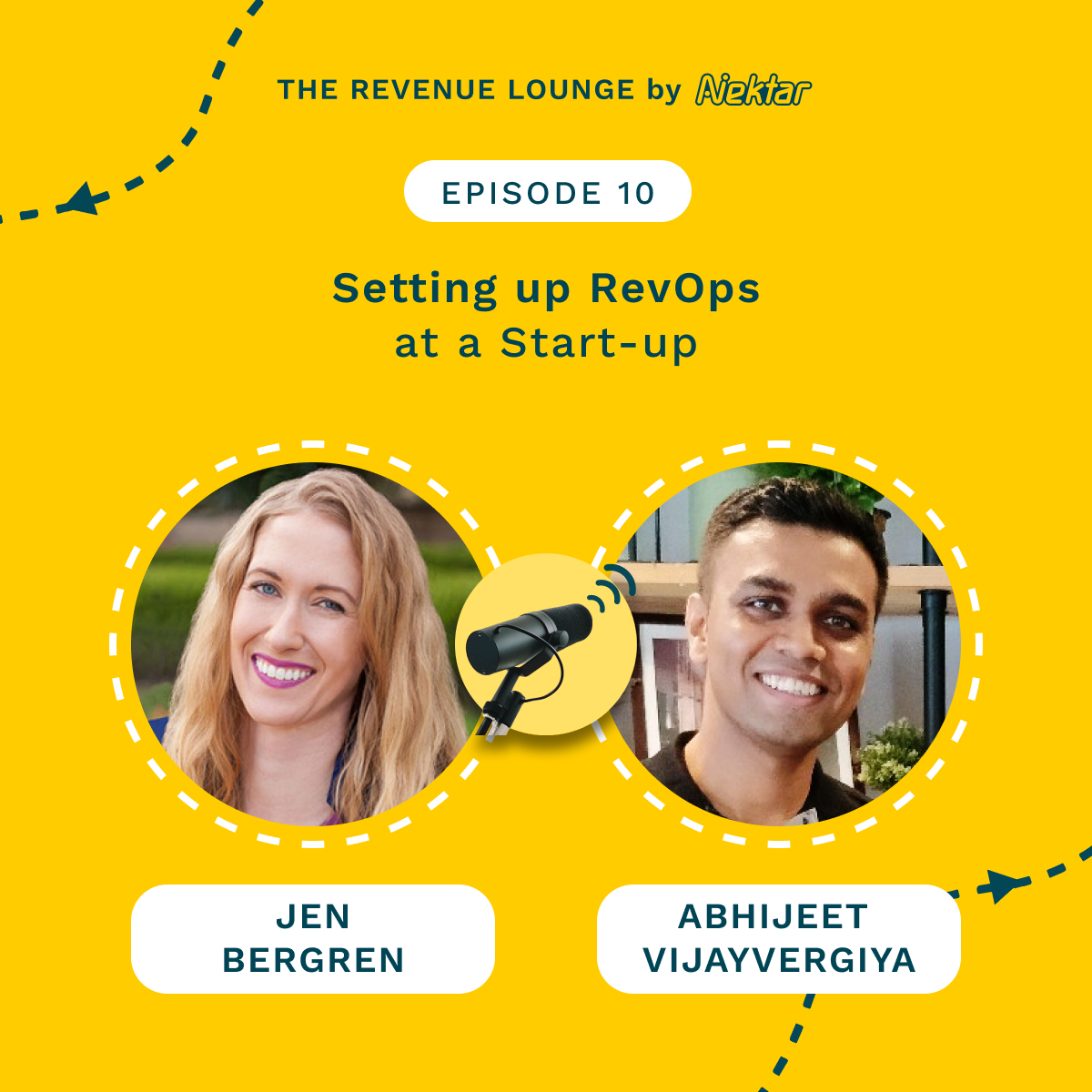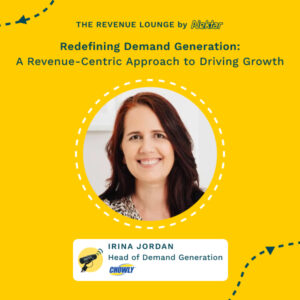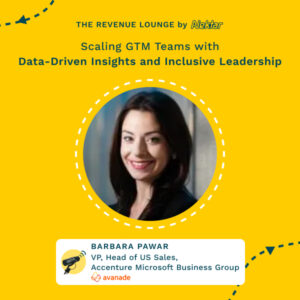Empowering Customer Success Through Data & AI ft. Aditya Vasudevan
July 17, 2024

About
The Revenue Lounge
The podcast covers stories from leaders across RevOps, Sales, Customer Success, GTM, Data and Marketing about what drives these functions and what advice they would share with our listeners. With 3 seasons recorded, the podcast currently features 50+ enterprise leaders in the B2B SaaS domain. Tune in to hear from the best in the business
This episode of the Revenue Lounge podcast features a discussion with Aditya Vasudevan, the Vice President of Customer Success at Cohesity. He shares insights on how data and AI is transforming the customer success function. Listeners can expect to learn strategies for leveraging data to enhance customer journeys, identify growth opportunities, and elevate customer satisfaction.
Guest Bio:
Aditya Vasudevan is the Vice President of Customer Success at Cohesity. He has over 22 years of experience spanning engineering, solution architecture, and customer success roles at companies like VMware, Hitachi, and startups.
Company Bio:
Cohesity is a cybersecurity company that provides data backup and recovery solutions for enterprises. They aim to help customers derive insights from their data while keeping it safe and secure. Earlier this year, Cohesity acquired Veritas’ data protection business.
Key Discussion Points:
– Importance of telemetry data from products and CRM to understand customer usage and journeys (00:06:22)
– Consolidating data into a data warehouse like Snowflake to enable analysis (00:07:23)
– Using analytics and dashboards to identify at-risk customers and expansion opportunities (00:10:12)
– Automating parts of customer journeys through digital nudges (00:11:19)
– Achieving 98% customer satisfaction score and highest customer retention rates through data-driven customer success (00:15:01)
Key Quote:
“If you have very good data and tools, you have deep AI. So you’re not doing a lot of the grunt work all the time. Your customer at risk. You know where the expansion opportunities are. So you’re very, very precise in your action.” (00:05:29)

[00:00:29] Randy Likas: Customer success teams often grapple with the challenge of transforming vast amounts of customer data into actionable insights.
[00:00:35] Randy Likas: But how is data in AI revolutionizing customer success and empowering teams to enhance customer satisfaction and drive long term loyalty?
[00:00:43] Randy Likas: Let’s find out.
[00:00:44] Randy Likas: Hello, everyone.
[00:00:45] Randy Likas: Welcome to the Revenue Lounge podcast.
[00:00:46] Randy Likas: I am your host, Randy Ai.
[00:00:48] Randy Likas: And in today’s episode, we have set out to uncover strategies to effectively leverage data, automate customer journeys, and identify growth opportunities, helping you elevate your customer success efforts to new heights in this data driven era.
[00:01:02] Randy Likas: Joining me today is Aditya Vasudevan.
[00:01:04] Randy Likas: Aditya is the vice president of customer success at Cohesity.
[00:01:07] Randy Likas: As a leader in customer success, Aditya ai in orchestrating transformative initiatives that elevate customer satisfaction and drive business growth.
[00:01:16] Randy Likas: With a focus on innovation and alignment with sales strategies, he has reshaped customer success delivery models for Cohesity.
[00:01:22] Randy Likas: Hello.
[00:01:22] Randy Likas: How are you today?
[00:01:24] 2: Very good, Randy.
[00:01:25] 2: Thank you for having me here.
[00:01:26] Randy Likas: Yeah.
[00:01:26] Randy Likas: I’m really excited for the conversation.
[00:01:28] Randy Likas: I generally like to kick things off and and just get to know you a little bit.
[00:01:31] Randy Likas: Maybe you could start by telling us a little bit about your background and how you got to your current role, at Cohesity.
[00:01:37] 2: Well, I started my career 22 years ago as an engineer, and I figured I enjoyed working more with customer.
[00:01:43] 2: So with a period of time, drifted more from the code to the customer.
[00:01:47] 2: I’ve worked with large service providers like Capgemini.
[00:01:49] 2: I worked at sort of VMware, Hitachi in various roles, development solution.
[00:01:54] 2: Prior to Cohesity, I, started a company in the area of Kubernetes back in the day, and that was really the fun funniest ride of my life, taking a very nascent idea and building a product and finding product market fit.
[00:02:07] 2: And that’s what I really enjoyed, finding where customers derive value out of product, iterating the product, and so doing presales, post sales, and success over there.
[00:02:17] 2: And then, you know, came to Cohesity.
[00:02:19] 2: And in the 1st 4 years, worked on the presale side, leading solution architects, winning top fortune 10 accounts, right, with technically complex POCs.
[00:02:28] 2: And then in the last one year, took on the role for customer success, ensuring they continue to grow and we retain those businesses.
[00:02:35] 2: So that’s, like, a brief, history of time.
00:02:39 Cohesity’s Acquisition of Veritas Data Protection Business: A Strategic Move
[00:02:38] Randy Likas: Excellent.
[00:02:38] Randy Likas: So in preparing for this interview, I did some research on Cohesity, and I saw that the enormous opportunity of her AI that that I had.
[00:02:45] Randy Likas: I also saw the announcement earlier this year that Cohesity had acquired the data protection business at Veritas.
[00:02:52] Randy Likas: So for those listeners who might not know about Cohesity, can you tell us a little bit about what the company does and maybe what you see as the opportunity ahead with the acquisition?
[00:03:00] 2: Yeah.
[00:03:00] 2: So Cohesity is in the cybersecurity business.
[00:03:03] 2: Right?
[00:03:03] 2: And 10 years ago, we would have called this backup, but it is cybersecurity today.
[00:03:07] 2: So we back up the digital assets, the data of large corporates, be it Oracle data, SQL data, NAS data, and protected from bad guys.
[00:03:16] 2: This data is kept safe in walls ai, sort of immutable file systems.
[00:03:21] 2: So when bad actors destroy the key production primary data, this becomes the last line of defense to restore their data.
[00:03:28] 2: We have been founded 10 years ago by Mohit Arun, who also founded Nutanix, who is a file system specialist in the world.
[00:03:34] 2: This is the godfather of converged infrastructure.
[00:03:37] 2: That’s the term we use.
[00:03:38] 2: And we’ve really hardened security, and we deliver scale, performance, and security to our customers.
[00:03:44] 2: That’s what we do.
[00:03:46] 2: The acquisition is we are very excited about it.
[00:03:48] 2: Obviously, can’t discuss more than what has been written in the media.
[00:03:51] 2: Yeah.
00:03:53 The Role of Data and AI in Customer Success
[00:03:52] 2: What it does, has been around for a long time.
[00:03:54] 2: They have a large number of fortune ai customers.
[00:03:57] 2: We have new tech and innovation, so we can marry that together and provide a lot more value to our, customer, joint customers.
[00:04:04] Randy Likas: Yeah.
[00:04:04] Randy Likas: I think it’s a a very exciting opportunity kind of what’s ahead.
[00:04:08] Randy Likas: I think when it as it relates to AI and and leveraging the capabilities that you’ve all built Randy taking that out to that customer base is certainly a a great opportunity.
[00:04:16] Randy Likas: Let’s talk a little bit more about AI Randy specifically in the role that you have around customer success.
[00:04:20] Randy Likas: So be interested to hear why is data Randy a relevant today in a customer success function Randy what opportunities are there ahead?
[00:04:29] 2: Yeah.
[00:04:30] 2: Just before I jump into the customer success dimension of it, we also have AI products at Cohesity where we help customers derive in insight from their own data.
[00:04:39] 2: So what is a backup Aditya, which can be dark Aditya, we give ai.
[00:04:43] 2: So you get double value out of the same assets.
[00:04:46] 2: But our today’s conversation is not focused on that.
[00:04:48] 2: We are not gonna focus on how to derive insight from your, unstructured data as an enterprise.
[00:04:54] 2: Our focus today is, you know, as a vendor, I do have data about my customer.
[00:04:59] 2: And what information I have about the customer, how can I use that digitally to enhance the customer experience, increase the retention, and how can I build AI on top of that?
[00:05:09] 2: Now you asked the question, why is this relevant?
[00:05:11] 2: I think the simple answer to that question is just scale and efficiency.
[00:05:15] 2: Randy, when is the last time your CFO gave you enormous budget to build customer success teams?
[00:05:21] 2: Probably never.
[00:05:22] 2: Right?
[00:05:22] 2: You never have more budgets.
[00:05:24] 2: You have to do with less.
[00:05:26] 2: That’s where data analytics and AI really helps you.
[00:05:29] 2: If you have very good data and tools, you have deep ai.
[00:05:32] 2: So you’re not doing a lot of the grunt work all the time.
[00:05:34] 2: Your customer at risk.
[00:05:36] 2: You know where the expansion opportunities are.
00:05:39 Utilizing AI for Customer Success: Overcoming Data Challenges
[00:05:38] 2: So you’re very, very precise in your action.
[00:05:40] 2: So you can, get a lot done with less resources.
[00:05:43] 2: That’s where data Randy AI become relevant for customer success.
[00:05:47] Randy Likas: So when I talk with other customer success leaders like yourself, they tell me our customer data resides in so many different systems.
[00:05:54] Randy Likas: Right?
[00:05:54] Randy Likas: It’s often siloed.
[00:05:54] Randy Likas: It’s difficult to combine that data.
[00:05:55] Randy Likas: What are some of the ai customer success.
[00:06:05] 2: You can see the smile on my face.
[00:06:07] 2: Like, all these problems that come into my head, that’s a key point.
[00:06:10] 2: So, number 1 is whether do you have the Aditya.
[00:06:14] 2: The sprawl of the data is problem number 2.
[00:06:16] 2: Now in you’re a legacy company with on prem products, you probably don’t have enough telemetry.
[00:06:22] 2: But if you’re a modern SaaS company, hopefully, you’ve worked with your product teams to build telemetry.
[00:06:27] 2: Product telemetry is key because I want to know whether my customer has, first of all, deployed my product.
[00:06:32] 2: Are they using my product?
[00:06:33] 2: What is the consumption?
[00:06:34] 2: How many licenses are they using?
[00:06:36] 2: What they’re not using?
[00:06:37] 2: Are they even interacting with the product?
[00:06:39] 2: Are they logging into it or not?
[00:06:41] 2: If it is a very dark product, right, with no information, then you’re sitting blind.
[00:06:45] 2: Then you are just down to human to human conversation and do best as you can, which is a very high touch model.
[00:06:51] 2: Now, fortunately, at Cohesity, we don’t have that problem.
[00:06:54] 2: We are a modern company.
[00:06:55] 2: You know, we are a cloud product, on prem product, but we have a lot of good telemetry.
[00:06:59] 2: So we can tell who is deploying the product, not deploying, in what phase of evolution they are.
[00:07:04] 2: So having the data is the key.
[00:07:05] 2: Right?
[00:07:05] 2: So one source of data becomes product and engineering.
[00:07:08] 2: Other source of data will obviously be your CRM, where you have sales transactions, where you have support case transactions, and what have you.
[00:07:16] 2: So having the data is key.
[00:07:17] 2: Multiple sources is obviously a problem.
00:07:20 Challenges in Data Management and Analytics
[00:07:19] 2: That’s where consolidation of data into a data warehouse is needed.
[00:07:23] 2: So you bring in data into something like a snowflake and then do meaningful question and answers on top of that.
[00:07:29] 2: After having the data, the second biggest problem I see or have heard of is accuracy of data.
[00:07:35] 2: Right?
[00:07:35] 2: Anybody you speak to, like, do I trust my data?
[00:07:38] 2: Is this really true?
[00:07:39] 2: So you have to go through a phase of vetting it out, doing a number of validation and test and spot checks that I can trust this.
[00:07:45] 2: I cannot trust this.
[00:07:46] 2: This is my good data, and I can build my business on, top of that.
[00:07:50] 2: So data availability, sprawl, consolidation, accuracy, these are some of, like, the foundational issues.
[00:07:58] 2: Then you have more advanced issues.
[00:07:59] 2: How are you querying?
[00:08:00] 2: What analytics you are building?
[00:08:02] 2: What kind of dashboards you have?
[00:08:04] 2: What kind of automation you have?
[00:08:05] 2: Those are more sophisticated and advanced problems.
[00:08:08] Randy Likas: Yeah.
[00:08:08] Randy Likas: Okay.
[00:08:08] Randy Likas: So number 1 is making sure we can identify the data.
[00:08:11] Randy Likas: Number 2 is getting the data into a common system ai a Snowflake or another data warehouse so that we can do that analysis, and then putting the tel telemetry in place for us to actually derive insights from that.
[00:08:22] Randy Likas: Am I hearing you correctly?
[00:08:23] 2: That’s right.
[00:08:23] 2: That’s right.
00:08:25 Using AI in Customer Success with Imperfect Data
[00:08:24] Randy Likas: Okay.
[00:08:24] Randy Likas: So oftentimes when we speak with companies, they we hear a common not complaint, but but frustration maybe in that Ai know that my data in not perfect.
[00:08:33] Randy Likas: I know that I we have some bad data in the system.
[00:08:36] Randy Likas: Now we all know that AI is dependent on good data.
[00:08:39] Randy Likas: So what, advice might you give for those that know that their data in perfect, but they wanna use AI applications as part of their customer success motion?
[00:08:46] Randy Likas: What approaches have you taken to really solve the problem?
[00:08:49] 2: Yeah.
[00:08:50] 2: So one thing what we need to realize is AI is useful today in unstructured data where there is a lot of text.
[00:08:57] 2: Now fortunately, in customer success, a lot of the data is tabular, columnar, and statistical, like your ACV number, your renewal date, your adoption number.
[00:09:07] 2: These are numbers.
[00:09:08] 2: And, actually, AI is not too good at analyzing that because AI, the way it works, it just tries to predict the next word, the next token.
[00:09:16] 2: Numbers are not words.
[00:09:17] 2: It it does not have historical context to predict the next word ai I ask you, is Randy’s business at risk?
[00:09:23] 2: It cannot figure that out because it is statistical analysis.
[00:09:26] 2: So, fortunately, a good 80% of analysis is statistical and number based and tools exist for that.
[00:09:31] 2: So you can clean that up.
[00:09:33] 2: AI is gonna be very interesting in unstructured data.
[00:09:36] 2: For example, customers are filing support cases.
[00:09:39] 2: Right?
[00:09:39] 2: Can you do some sentiment analysis in those words to say, are they referring your competitor over there?
[00:09:45] 2: Are you sensing a very negative tone?
00:09:48 Using Data and AI to Enhance Customer Success
[00:09:47] 2: Are they feeling very low, or are they feeling upbeat about you?
[00:09:50] 2: Those are the signals that AI can really help you with and augment your statistical analysis in addition to that.
[00:09:57] 2: Now how have we dealt, with all these data and AI problems in customer success?
[00:10:01] 2: So we’ve used our telemetry from our CRMs and the product, into a data warehouse such as Snowflake.
[00:10:08] 2: We have asked the relevant questions for our business, and we have built visualization in Tableau.
[00:10:12] 2: Like, what are our top customers?
[00:10:14] 2: What products are they using?
[00:10:15] 2: What are they not using?
[00:10:17] 2: When is the next renewal?
[00:10:18] 2: What is at risk?
[00:10:19] 2: Are they having support issues?
[00:10:21] 2: Where is the hotspot over there?
[00:10:22] 2: So you ask a set of questions that’s relevant to your business and build visualization on top of it, and then you go from there.
[00:10:30] 2: Now you can do some automation on top of it.
[00:10:32] 2: For example, which customer has a renewal in the next 6 months and has a low adoption?
[00:10:37] 2: Make a list of those accounts, and your CSMs can go and focus on that.
[00:10:41] 2: Now instead of spraying and praying, you have a very targeted list to focus on and where to act.
[00:10:46] 2: This is how you get efficiencies in your system.
[00:10:49] 2: So we have done the basic telemetry.
[00:10:51] 2: We have done the snowflake layer.
[00:10:52] 2: We have done the tableau layer.
[00:10:54] 2: Now so this is I I would call this, like, basics.
[00:10:57] 2: Now beyond ai, things get more interesting.
[00:10:59] 2: So about 3 or 4 months ago, we started the concept of digital journey mapping.
[00:11:04] 2: What that means is every customer has a journey with the product.
[00:11:07] 2: Right?
[00:11:07] 2: And what’s a good journey looks like for your customer?
[00:11:11] 2: Can you get digital signals and signatures from your product to see in every customer following that pattern?
[00:11:17] 2: And if the customer is not following that pattern, you send them a nudge.
[00:11:19] 2: Maybe you send them a a digital nudge, an email nudge, or finally give them a call.
[00:11:24] 2: So for example, in our business, we are securing customer data assets.
[00:11:28] 2: We know most customers have Oracle servers, SQL servers, NAS servers, NetApp servers, what have you, cloud Vasudevan.
[00:11:35] 2: And we see that there is a journey.
[00:11:37] 2: If if you are backing up this but not backing up that, something seems odd.
[00:11:41] 2: Or if you have backed up this but made only one copy of it, this is a very critical crown jewel data.
[00:11:47] 2: You should have 2 copy of it.
[00:11:48] 2: We know what a good journey looks ai, and we can do a notch.
[00:11:51] 2: So I think that is a second frontier, the digital journey.
[00:11:55] 2: And the last frontier is the AI journey.
[00:11:57] 2: Right?
[00:11:57] 2: And the AI journey is where I gave you examples of sentiment analysis.
[00:12:02] 2: So we are in an experimental phase, I would say.
[00:12:04] 2: We have taken our own cohesity ai product and some other industry AI LLMs to throw, like, case data at it, to throw emails at it, and see if it can tell me what is at risk versus not, where the sentiment is bad versus good.
[00:12:17] 2: And we are going to plumb once we are through our sort of efforts to understand this is reliable data, we’ll plumb that signal into our tableau, into our analysis to say AI thinks there is a problem here, there is a risk.
[00:12:28] 2: It will give you a red, yellow, green to go and focus on.
00:12:33 AI in Digital Transformation: Conversational Data and Insights
[00:12:32] Randy Likas: Yep.
[00:12:32] Randy Likas: That’s really fascinating.
[00:12:33] Randy Likas: How much of this that you’ve built is programmed in the sense of it it in knows what to look for versus what I think the holy grail is, which is ai having a conversation with your data and being able to ask ad hoc questions on the fly and have it generate the data and and and spit out the insight.
[00:12:48] Randy Likas: Right?
[00:12:48] Randy Likas: We’d love to understand that evolution in terms of where you are and maybe where you think the opportunities are ahead of with that.
[00:12:54] 2: Yeah.
[00:12:55] 2: Great point.
[00:12:55] 2: You know, just yesterday, we were having a chat.
[00:12:57] 2: How can we make data conversational?
[00:13:00] 2: So with the current set of AI tools, it’s not pretty straightforward because a lot of the CS data is structural whereas AI is conversational.
[00:13:08] 2: But there are maybe companies like Torchspot or even Snowflake and Tableau have those tabular data to queryable language capabilities.
[00:13:16] 2: We are still exploring that.
[00:13:17] 2: But what we have done with our digital data is we know what good looks like just from experience.
[00:13:24] 2: And we have tried to model that, and we look for that good.
[00:13:26] 2: And when we don’t see the good, we know what the bad looks like.
[00:13:29] 2: Where, the AI is helping us is is finding signals from cases, emails, interactions that shows, what’s problematic.
[00:13:38] 2: So the digital journey mapping is because we know our product.
[00:13:42] 2: We know how to build it.
[00:13:43] 2: There is another layer that is possible over there.
[00:13:46] 2: If you look at your 100 customer’ digital journey, you can actually train your system to tell this is what good looks like because, again, there are a bunch of APIs and lock ai.
[00:13:56] 2: Then it can go and automatically find what bad looks like.
[00:14:00] 2: But we that’s very early for us.
[00:14:02] 2: We have not gotten there.
[00:14:04] 2: I I know there are a few startups who are dabbling with this to see, you know, they look for patterns on what good looks like Randy they do what bad looks ai.
[00:14:11] 2: But we are not there yet.
00:14:13 How AI is Driving Business Impact in Customer Success
[00:14:12] 2: But we have another method using which because we know the first ten set of good APIs to look for Randy the digital signatures.
[00:14:18] 2: And once we don’t see it, we know it’s time to nudge.
[00:14:21] Randy Likas: Fantastic.
[00:14:22] Randy Likas: Can you give us, ai, Likas, a tangible example?
[00:14:24] Randy Likas: Ai, I know what I’m hearing you say is, like, the AI is is really helping us identify signals, risk factors, things like that.
[00:14:30] Randy Likas: But maybe an example of where the insights derived from the Ai has has made an actual business impact either saved a large customer or increased your NRR from a certain percentage.
[00:14:41] Randy Likas: We’d love to hear just sort of some business impact examples that you you’ve seen.
[00:14:44] 2: Absolutely.
[00:14:44] 2: So all these, like, the entire digital initiatives and everything has helped us, first of all, in terms of scale cover more accounts.
[00:14:51] 2: Covering more accounts, what it has meant is we have reached the highest retention rate we ever had in a business because now we are able to touch a lot more accounts.
[00:15:01] 2: The efficiency gains mean that our CS team members are less frustrated and more happy because at one stop shop, they have all the relevant ai data to have a conversation.
[00:15:10] 2: Earlier, they would go spread around, everywhere to look for relevant stuff.
[00:15:15] 2: So there is efficiency.
[00:15:16] 2: There is high retention rate.
[00:15:18] 2: There is more accounts, that are covered.
[00:15:20] 2: And, our customer success team got a CSAT rating of 98% out of 100, in the last quarter.
[00:15:28] 2: So these are some tangible benefits, and our customers have benefited too.
[00:15:31] 2: Like, their adoption numbers have have gone up, and I don’t want to give out customer Aditya, but, which means they are securing more digital ai assets, which means they are more secure.
[00:15:41] 2: In if they were to be faced with an unfortunate ransomware attack, which is very common these days, then, you know, we’ll be able to help them, recover data at scale at high speed.
[00:15:51] Randy Likas: What examples or advice might you give for an organization who’s not quite as far as you guys are in the journey?
[00:15:57] Randy Likas: Right?
[00:15:57] Randy Likas: They wanna start doing some of these things, but they don’t quite know where to start.
[00:16:01] Randy Likas: Any advice that you would give to do the blocking and tackling to get to a point to where the success that you’ve had today?
[00:16:08] 2: Yeah.
[00:16:09] 2: These are all iterations.
[00:16:10] 2: Right?
[00:16:10] 2: I think first perfect manual processes, figure out what works for your business, keep the customer at the center, and measure the metrics based on what value you deliver to them.
[00:16:20] 2: So if I’m securing the customer, I have to measure how secured I have made the customer, build a metric around them for coverage.
00:16:28 Using AI to Identify Growth Opportunities in Customer Segments
[00:16:27] 2: Once you perfect the manual one, then enter the digital world.
[00:16:30] 2: Right?
[00:16:30] 2: And that’s where you would start.
[00:16:31] 2: First of all, do I have the data Randy the telemetry?
[00:16:33] 2: And then is it clean and accurate?
[00:16:35] 2: And then how do I analyze?
[00:16:37] 2: So those are the layers.
[00:16:38] 2: But if you don’t have the manual process figured out, going digital is harder.
[00:16:42] Randy Likas: Yep.
[00:16:43] Randy Likas: Fantastic.
[00:16:43] Randy Likas: So we we talked about identifying risk factors, product usage, like some of those things.
[00:16:48] Randy Likas: What about identifying cross sell opportunities or growth opportunities?
[00:16:51] Randy Likas: How has AI been used that you’ve seen so far to to identify some of the expansion or the growth opportunities?
[00:16:58] 2: Yeah.
[00:16:59] 2: So if we look at a customer, let’s say we have a financial customer of in a certain segment, be it enterprise segment.
[00:17:05] 2: We generally know what a financial customer in enterprise segment should look like.
[00:17:10] 2: Mhmm.
[00:17:10] 2: They should be backing up asset a, b, c, d, e.
[00:17:13] 2: So if a customer is backing up or securing only 2 assets, then we’re ai, this is not matching the industry pattern.
[00:17:20] 2: Hey.
[00:17:20] 2: Most customers in your segment are also doing this.
[00:17:23] 2: Do you have this asset?
[00:17:24] 2: Don’t you want to secure it?
[00:17:25] 2: That’s where the, upsell opportunities come, where you can get ai more adoption of your product.
[00:17:31] 2: And then the other opportunities that you can look at is use cases.
[00:17:34] 2: When customers secure certain digital assets, some make one copy, some make 2 copies, some make 3 copies.
[00:17:40] 2: But if you’re a financial customer, there are regulatory requirements to have at least 3 copies at certain locations.
[00:17:46] 2: It’s ai most customers in your segment are doing this.
[00:17:48] 2: Why are you not doing this?
[00:17:50] 2: Isn’t this, like, your lack of ai?
[00:17:52] 2: And can we help you?
[00:17:53] 2: So that data gives you that insight.
[00:17:55] 2: So now when you’re going into a QBR, you are way more smarter.
[00:17:58] Randy Likas: Mhmm.
[00:17:59] 2: You’re like, hey, customer.
[00:18:00] 2: You bought this product for this value.
[00:18:02] 2: You have derived value x, but you can go to y.
[00:18:05] 2: You have to look at my vaulting product.
[00:18:06] 2: You have to back up your Oracle assets.
[00:18:08] 2: You have to make your second and third copy at this site.
[00:18:11] 2: This will be your complete security posture, basically.
[00:18:14] 2: And they’re like, yes.
[00:18:15] 2: Thank you for bringing that to my attention.
[00:18:17] 2: See, at the end of the day, you’re helping your customer counterpart part achieve their goals.
00:18:22 Using Data Insights for Upsell and Cross Sell Opportunities in Sales Conversations
[00:18:21] 2: Right?
[00:18:22] 2: Mhmm.
[00:18:22] 2: If you don’t help them do that, they’re not gonna work with you.
[00:18:25] 2: And this kind of insight helps them.
[00:18:26] 2: Randy times when you’re having a conversation with customer, they may not entirely know their real estate and asset, but these digital insights actually help them ask internal questions and get smarter.
[00:18:37] 2: So that’s how we have used this data for upsell and cross sell opportunities.
[00:18:41] Randy Likas: Are you using AI at all to help identify the types of personas that maybe get involved that might not be part of the original sale for those cross sell opportunity?
[00:18:51] Randy Likas: So think about a buying committee of multiple stakeholders that take ai the initial purchase.
[00:18:56] Randy Likas: But now as you’re looking to expand, maybe there’s new personas or new people that you’d get involved.
[00:19:01] Randy Likas: Is it helping out you also understand, like, hey.
[00:19:03] Randy Likas: We have to go talk to this person.
[00:19:04] Randy Likas: Right?
[00:19:05] Randy Likas: We haven’t spoke spoke to them yet in order for us to go win this deal.
[00:19:09] 2: Now we haven’t done that.
[00:19:10] 2: And, for our use cases, we don’t need it.
[00:19:13] 2: But if you’re a company with, like, 100 products, then I can imagine that is needed.
[00:19:17] 2: We are a company of tens of products, and so it’s very controllable for us.
[00:19:21] 2: One set of buyers are of persona a, and we know the second persona.
[00:19:25] 2: So it’s much easier.
[00:19:26] 2: Here, we don’t have a sprawl problem where AI can really help us.
[00:19:30] 2: So we haven’t put that use case to the test with AI.
[00:19:33] 2: But I can imagine if you’re a corporation with 100, 200 products, and they all have different personas, then somebody can take advantage of that too.
[00:19:42] 2: Yeah.
00:19:42 Building a Business Case for AI in Customer Success
[00:19:42] Randy Likas: Yeah.
[00:19:43] Randy Likas: I’d love to hear how you got this started.
[00:19:46] Randy Likas: Right?
[00:19:46] Randy Likas: Could could I think you’re one of the more advanced companies using AI for customer success that Ai spoken with.
[00:19:51] Randy Likas: But, like, when you wanted to build that initial business case to get that funding to start building some of those things, what was that conversation like?
[00:19:57] Randy Likas: Who did you have to go to?
[00:19:58] Randy Likas: What were some of the KPIs or metrics that you said that this is gonna impact?
[00:20:01] Randy Likas: I’m just trying to think for the audience, like, how might they go try to get something funded, a Skunk Works project or whatever else to get going?
[00:20:08] 2: It’s, in your annual budget cycle.
[00:20:11] 2: If you’re gonna go and ask for more budget, to scale your teams, that’s an opportunity to say, hey, instead of one additional rec, can I get some experimental budget to play with this?
[00:20:23] 2: Either to buy a product, do a POC, or do something in house.
[00:20:26] 2: Now we are a high-tech company.
[00:20:28] 2: We have our own AI project.
[00:20:29] 2: So this was much an easier conversation internally.
[00:20:33] 2: But if for other brick and mortar businesses or other businesses, it’s comes down to because it comes down to scaling and efficiency.
[00:20:39] 2: With less dollars, you’re gonna get more out.
[00:20:41] 2: And so you carve out a piece of your budget in your next budget cycle to do these experiments.
[00:20:46] 2: And it’s always a trade off against, a wreck that you were gonna ask, basically.
[00:20:51] Randy Likas: So I know that you said you use your product, for a lot of this.
[00:20:54] Randy Likas: Is most of the the work that you’ve done a proprietary you know, you built it yourself with your data warehouse, or is there any off the shelf packages that you’ve used to help sort of do this?
[00:21:05] 2: No.
[00:21:05] 2: Off the shelf.
[00:21:06] 2: So, see, our AI also uses industry LLMs.
[00:21:11] 2: So Mhmm.
[00:21:11] 2: I could literally do this with open AI or other tools as well.
[00:21:14] 2: And a lot of the other standard things ai snowflakes of the world, the Tableau’s of the world, which solves actually 80% of the CS problems are already out there.
[00:21:22] 2: So, no, I wouldn’t say this is, proprietary.
[00:21:25] 2: We use our products, but we also, in parallel, tested, sort of some other in products, and this can be solved with, them as well.
00:21:34 Aditya Vasudevan on the Joy of Solving Customer Problems in Customer Success
[00:21:33] Randy Likas: Yep.
[00:21:34] Randy Likas: Fantastic.
[00:21:35] Randy Likas: Let’s transition a little bit to a lightning round, which is more personal questions about yourself.
[00:21:39] Randy Likas: So we’d love to hear, now that you’ve moved into customer success, which sounds like you’re really, you know, passionate about right now, what what’s some of the favorite things about being the the head of customer success at a company like Cohesity?
[00:21:49] 2: I’ve, I think the the funniest part of it is is solving customer problems.
[00:21:55] 2: Customer is the heart of any business.
[00:21:57] 2: Right?
[00:21:57] 2: See, even when we started a company 10 years ago, as, like, you can imagine, you can have a vision, you can build a product, but the rubber meets the road when the customer extracts value.
[00:22:07] 2: That is the fun.
[00:22:08] 2: Right?
[00:22:09] 2: So when you’re sitting in front of a customer, you’re doing a POC, you’re selling, or seeing the customer derive value.
[00:22:14] 2: That is the joyous part for me.
[00:22:16] 2: Because for most, like, for profit business, customer is the heart of the business.
[00:22:20] 2: Right?
[00:22:20] 2: So that’s what I enjoy, solving their problems, delivering value, scaling, and figuring out what works, what doesn’t work.
[00:22:27] 2: Because you may not have the perfect product or you may not have all the features.
[00:22:30] 2: Like, figuring out where the friction points are, bringing out those feedback Randy achieving a product market fit in tuning the product.
[00:22:37] 2: Ai?
[00:22:37] 2: So I think those are the things I truly enjoy, solving problems, at scale for customer digitally using the products.
00:22:45 Leading Customer Success at Cohesity
[00:22:44] Randy Likas: Yeah.
[00:22:45] Randy Likas: What about the the flip side of that question?
[00:22:47] Randy Likas: What’s your least favorite part about leading success at Eco e City?
[00:22:50] 2: I can’t think of 1.
[00:22:51] 2: You know, all the good stuff may come with some small pain, but that’s kind of acceptable.
[00:22:55] 2: I think the analogy I’ll give is Ai have a second kid who in, like, 5 weeks old, and sleep cycles and everything is impacted.
[00:23:02] 2: But those moments in the day are, like, truly joyful for which you wait for and you live for.
[00:23:06] 2: So I think it’s a part and parcel.
[00:23:08] 2: I don’t think, like, there is a part of it that I hate.
[00:23:10] 2: The whole package works for me.
[00:23:12] Randy Likas: Yeah.
[00:23:13] Randy Likas: Success question a little bit different way.
[00:23:14] Randy Likas: What what’s the hardest part of your job?
[00:23:18] 2: I think, the hardest part of the job is getting alignment and support of other people to get things done.
[00:23:26] 2: And I I think be sales engineering product or support.
[00:23:30] 2: Right?
[00:23:30] 2: Because you are if I may say, we use the word quarterback.
[00:23:33] 2: You’re quarterbacking an account to an outcome, but you alone cannot do everything.
[00:23:37] 2: So your ability to convince other people and collaborate is the key, and that is the heart of customer success, Your skills in doing that.
[00:23:45] Randy Likas: Yep.
[00:23:45] Randy Likas: If
[00:23:46] 2: you master that, you will be very successful.
[00:23:48] Randy Likas: Yep.
[00:23:48] Randy Likas: Both internally as well as externally.
[00:23:49] Randy Likas: Right?
[00:23:50] Randy Likas: Your internal partners.
[00:23:51] Randy Likas: Exactly.
[00:23:51] Randy Likas: What’s one piece of advice that maybe you’ve received from recent past or even way back when that that is stated with that maybe you can share with the audience?
[00:23:59] 2: Yeah.
[00:23:59] 2: There are so Randy, but as I first started working a lot with customers back 10, 15 years ago, and that’s the time when we were starting my ai, I had an ai because I was starting the company for the first time, and that was a seasoned entrepreneur.
[00:24:12] 2: I said, what are the top three things I should think about to be successful and not have pitfalls in my startup?
[00:24:18] 2: And he said, here are the top three things.
[00:24:20] 2: He said, number 1, focus on your customer.
[00:24:23] 2: K?
[00:24:24] 2: Number 2, focus on your customer.
[00:24:26] 2: Number 3, focus on your customer.
[00:24:28] 2: That is ai a simple lesson to remember because we get caught up in so many other details.
[00:24:33] 2: What is the industry tent?
[00:24:34] 2: What is my competitor doing?
[00:24:36] 2: And just ruthless, brutally focus on the customer, their problem, focus on delivering enormous value, and good things will automatically happen to you.
[00:24:45] Randy Likas: Yeah.
[00:24:45] Randy Likas: I think that’s great advice no matter what role you’re in.
[00:24:48] Randy Likas: Absolutely.
[00:24:49] Randy Likas: What about if someone who’s maybe a CSM starting their career, they wanted to where you are today.
[00:24:55] Randy Likas: They wanna lead a customer success organization in the future.
[00:24:57] Randy Likas: What advice might you give them to help get them there?
[00:25:00] 2: Well, apart from some we touched upon, like, focus on the customer and such, the one thing I would say is your sort of domain knowledge to loosely use that word or technical knowledge.
[00:25:10] 2: Quite often, I see, like, junior CSMs just managing sentiment or account and being the messenger.
[00:25:18] 2: You should be able to hold a intelligent conversation with your customer partner about your business, the business value, the technical value so that you earn their respect.
[00:25:28] 2: I think it is very important to know your business and not just be a messenger.
[00:25:33] 2: The other thing I think is because you’re not gonna be successful without getting the support of other people, your skills in collaborative alignment with others.
[00:25:41] 2: You know, you can’t, like, go to your support and engineering partner and say, hey.
[00:25:44] 2: Help me do this.
[00:25:45] 2: They’re like, I don’t have time to do this.
[00:25:47] 2: But the conversation has to be, hey.
[00:25:49] 2: I have a customer who spent $5,000,000 with us.
[00:25:51] 2: They expect certain things.
[00:25:53] 2: Now to retain and grow this customer, they have this pain.
[00:25:56] 2: Will you please help me solve?
[00:25:57] 2: And I don’t know of one person who will say no to that.
[00:26:00] 2: They are gonna say yes to that.
[00:26:02] 2: Because if you’re an engineer, you have stock options in the company.
[00:26:04] 2: You have other KPIs that you can relate and align to when you message like that.
[00:26:09] 2: At the center of my conversation is the customer, what we owe to them, what they spent with us.
[00:26:14] 2: Right?
[00:26:15] 2: And so please help me achieve this value.
[00:26:17] 2: And and the human tendency is to help, but the way you structure and frame in is very important.
[00:26:21] 2: So I think those are some of the things, and we gotta be, like, thankful and grateful to all our partners who help us, but this is how you get everybody together to deliver an outcome.
00:26:31 Innovative Problem Solving with Aditya Vasudevan
[00:26:30] Randy Likas: Yeah.
[00:26:30] Randy Likas: Yeah.
[00:26:31] Randy Likas: Fantastic advice.
[00:26:32] Randy Likas: So let’s say you’ve got a big, meaty challenge, something that maybe you haven’t tackled before or or you’re just trying to figure it out, where do you turn to for advice?
[00:26:39] Randy Likas: Do you go to peers that you know?
[00:26:42] Randy Likas: Do you go to, like, the industry analyst firms and look Randy the research?
[00:26:46] Randy Likas: We’d love to understand what sources you go to try to solve solve a big problem.
[00:26:49] 2: I tend to go to, practitioners, people who have, done it or are doing it, because I’m very experiential in my approach.
[00:26:57] 2: I I don’t I learn less from books.
[00:27:00] 2: I do more from doing with my hand.
[00:27:02] 2: So I tend to go to industry practitioners who are dealing with those problems, all are looking at those kind of problems and do brainstorming sessions.
[00:27:10] 2: Hey.
[00:27:10] 2: These are the kind of problems.
[00:27:11] 2: How are you approaching?
[00:27:12] 2: How am I approaching?
[00:27:13] 2: What are your best practices that you have seen?
[00:27:15] 2: And so this can be within the company, leaders, juniors, and and it’s very important to get a diverse view.
[00:27:22] 2: So if you just go and speak to customer success team, you will get a very singular view of of that.
[00:27:26] 2: You have to speak to sales, support, engineering to get a very holistic view.
[00:27:32] 2: And whatever you curate, do definitely bounce it off a Yeah.
[00:27:36] 2: Ai goes back to your advice.
[00:27:42] Randy Likas: Yeah.
[00:27:42] Randy Likas: It goes back to your ai.
[00:27:44] Randy Likas: Focus on the customer.
[00:27:44] Randy Likas: Focus on the customer.
[00:27:45] Randy Likas: Right?
[00:27:46] Randy Likas: Because they’re gonna help us understand priority.
[00:27:48] Randy Likas: Right?
[00:27:48] Randy Likas: They’re gonna help us maybe solve the problem, so ai
[00:27:50] 2: so forth.
[00:27:51] 2: So excellent.
[00:27:52] 2: One thing about that is if you are at the bleeding edge of innovation, they may not get it.
[00:27:56] 2: But that’s when you need to know what question to ask and what not to ask.
[00:28:00] 2: This reminds me of a great old, story about the Sony Walkman.
[00:28:03] 2: Right?
[00:28:04] 2: When Akio Morita built the Walkman, nobody ever got it.
[00:28:07] 2: Like, why would I ever buy it?
[00:28:09] 2: So he never tried convincing.
[00:28:10] 2: The only thing he did was he gave a bunch of college kids the Walkman and asked them to walk around the park.
[00:28:16] 2: And they did that for a month Randy everybody got it.
[00:28:18] 2: Oh, this is my personal music.
[00:28:20] 2: I just got it.
[00:28:22] 2: So you have to know what questions to ask, when to ask, and who to ask.
[00:28:25] 2: If with every innovation you keep asking the customer, do you want?
[00:28:27] 2: They’re gonna say no.
[00:28:28] 2: So you’ve gotta be careful.
[00:28:30] Randy Likas: Yeah.
[00:28:30] Randy Likas: Reminds me of the old Henry Ford story.
[00:28:31] Randy Likas: Right?
[00:28:31] Randy Likas: If you ask somebody back then what what they wanted, they would tell you they wanted a faster horse.
[00:28:31] Randy Likas: Right?
[00:28:32] Randy Likas: They didn’t know what a car was.
[00:28:36] Randy Likas: Ai you focus on the problem, what do you what would that enable you to do?
[00:28:40] Randy Likas: And that’s gonna help you get to your answer.
[00:28:42] Randy Likas: So Yeah.
[00:28:43] Randy Likas: I wanna say thank you very much for spending the time.
00:28:46 Insightful Conversation on Company Strategy and Market Trends
[00:28:45] Randy Likas: I think it was a really insightful conversation.
[00:28:47] Randy Likas: I think our audience are gonna take away quite a bit from it.
[00:28:49] 2: Thank you for having me, Randy.
[00:28:51] 2: Very good chat.
[00:28:52] 2: Good luck.
[00:28:52] Randy Likas: Alright.
[00:28:52] Randy Likas: Have a good one.

Ep #1: Navigating the Downturn with a Hyperfocus on Productivity
Listen Now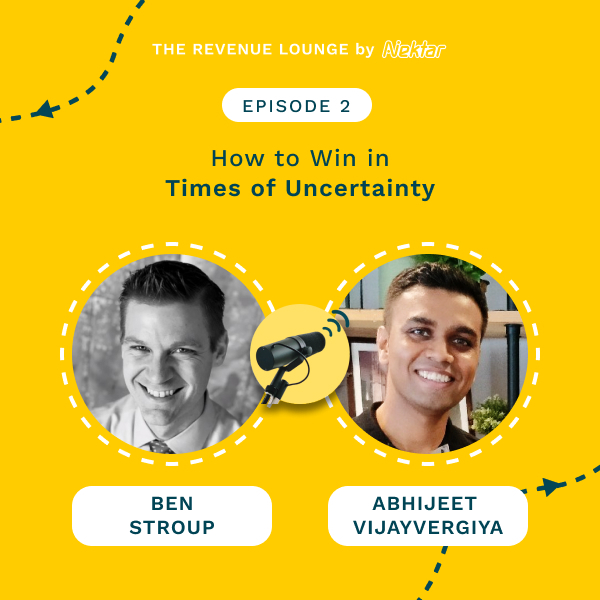
Ep #2: How to Win in Times of Uncertainty
Listen Now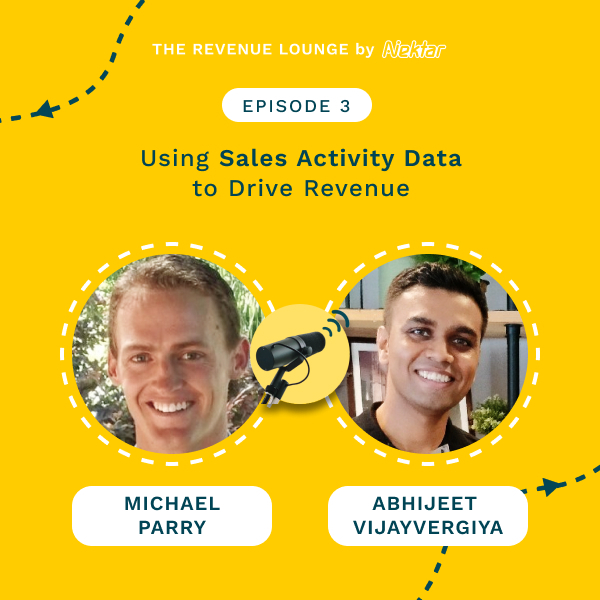
Ep #3: Using Activity Data to Drive Sales Productivity
Listen Now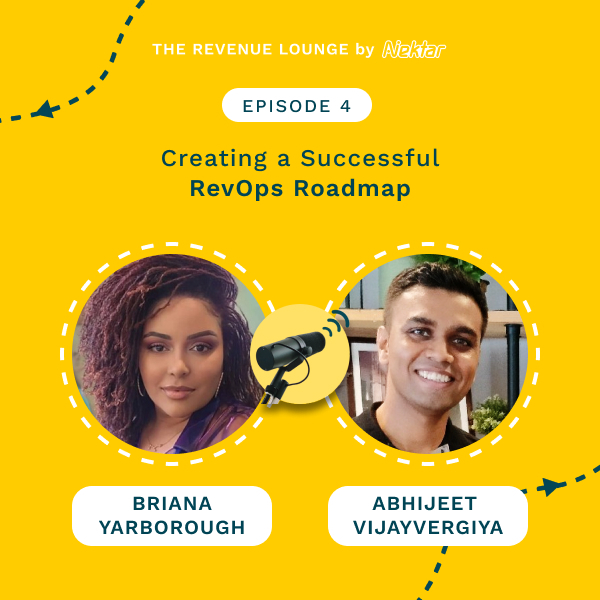
Ep #4: Creating a Successful RevOps Roadmap
Listen Now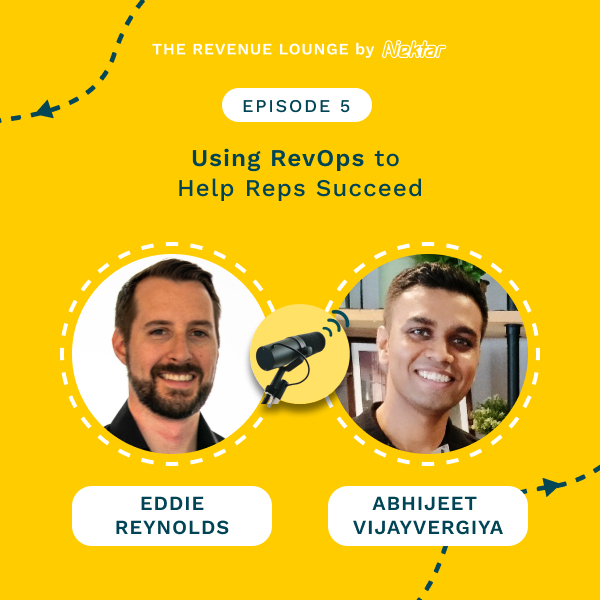
Ep #5: Using RevOps to Help Reps Succeed
Listen Now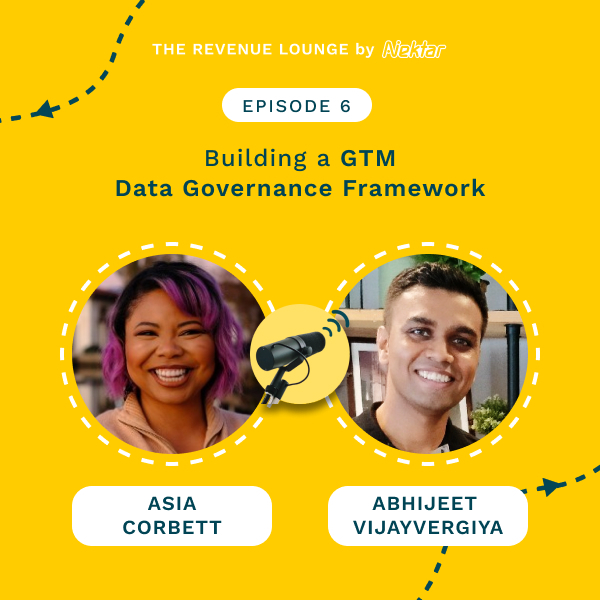
Ep #6: Building a GTM Data Governance Framework
Listen Now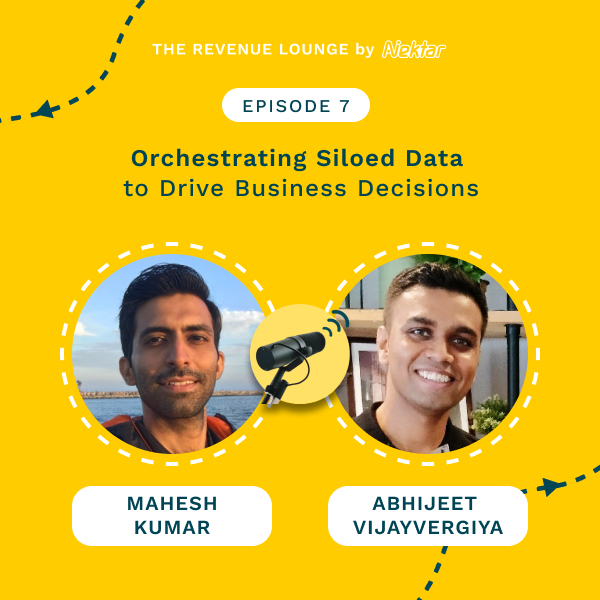
Ep #7: Orchestrating Siloed Data to Drive Business Decisions
Listen Now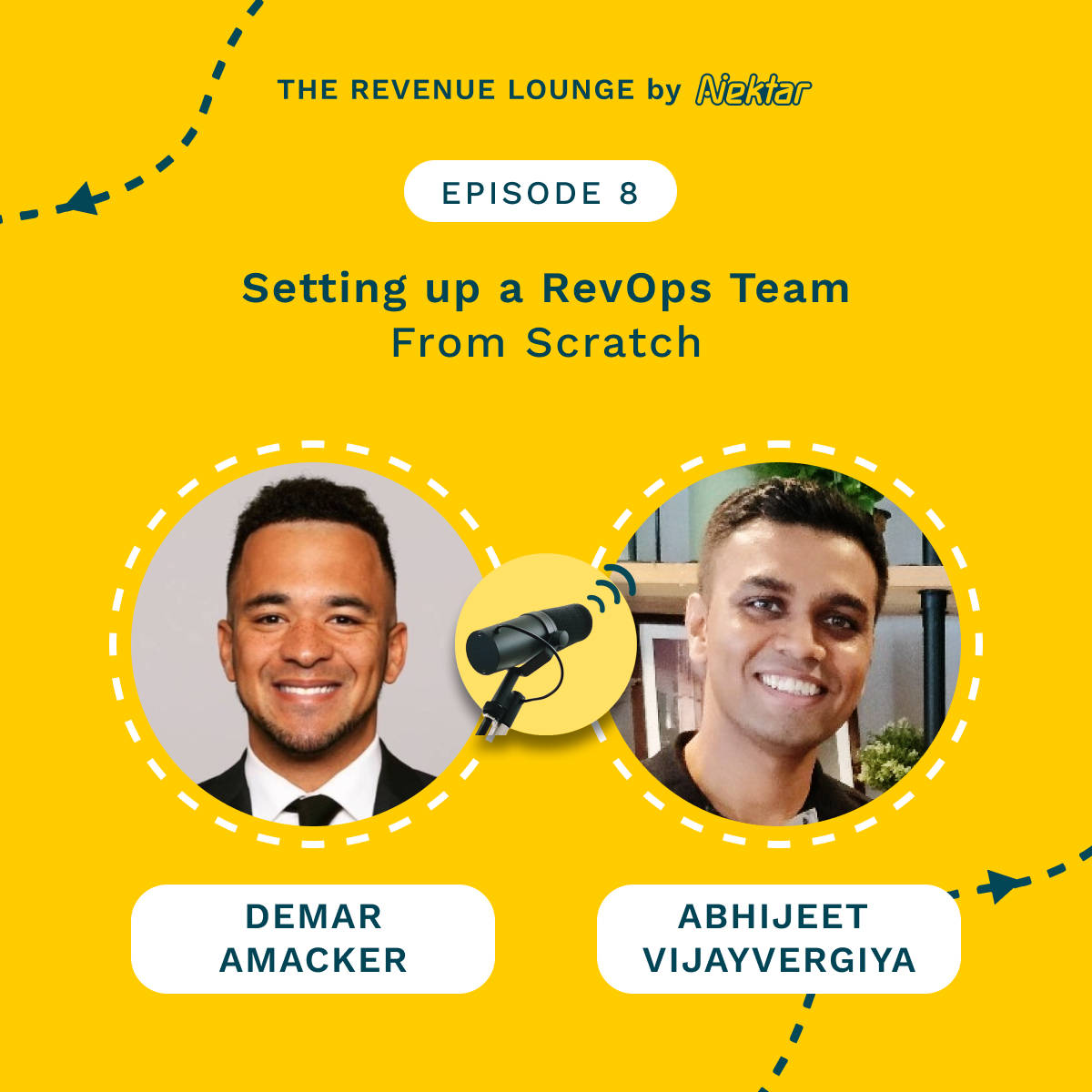
Ep #8: Setting Up a RevOps Team From Scratch
Listen Now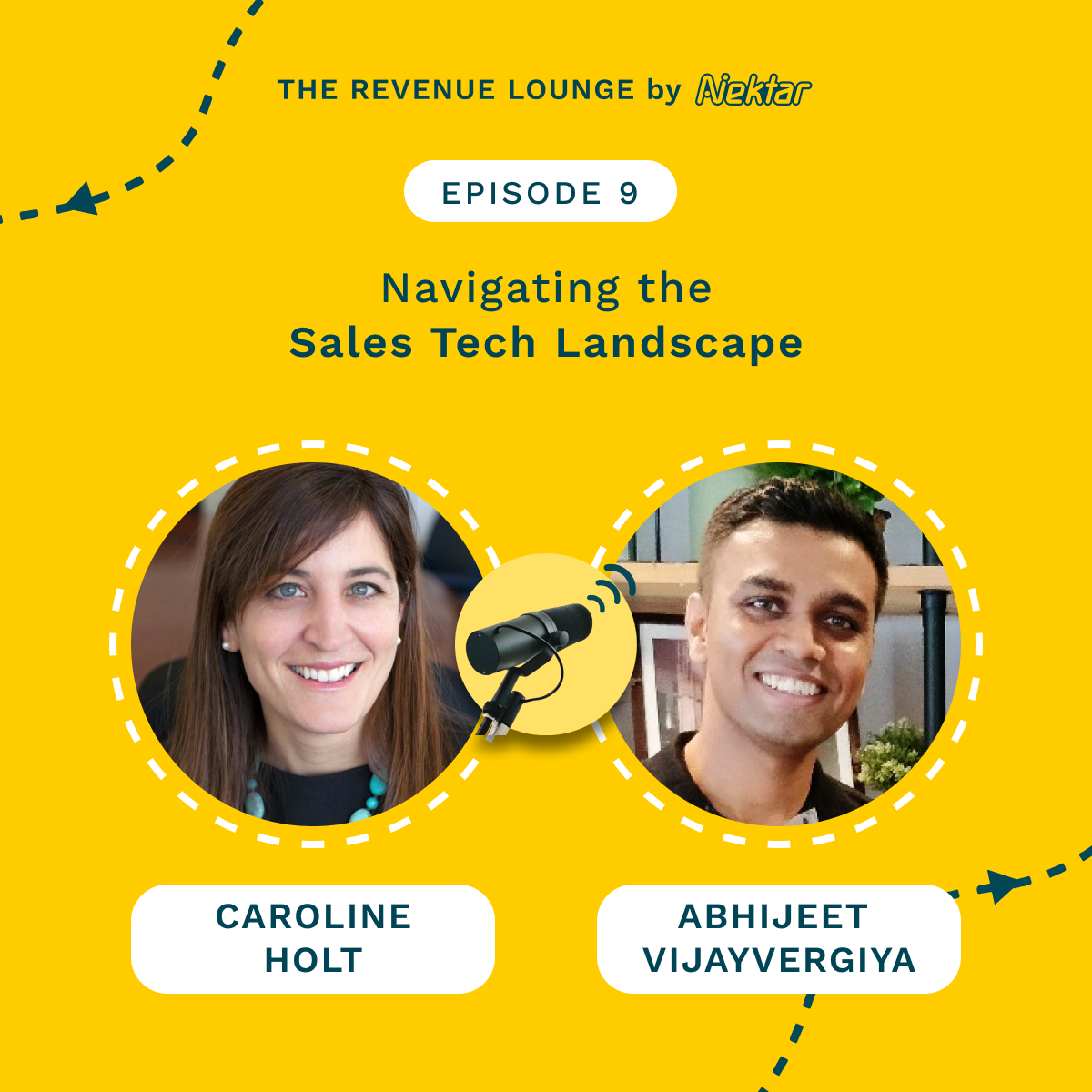
Ep #9: Navigating the Sales Tech Landscape
Listen Now